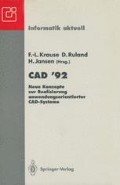Zusammenfassung
Simultaneous Engineering ist eines der Schlüsselkonzepte zur Reduzierung von Entwicklungs- und Fertigungszeiten. Teil dieses Konzeptes ist die sogenannte Verteilte Konstruktion, die die gleichzeitige bzw. parallel versetzte Entwicklung eines Produktes oder einer technischen Lösung ermöglichen soll. Für die Verteilte Konstruktion werden Mechanismen zur Aufgabenzerlegung, parallelen Entwicklung von Teillösungen und deren Zusammenführung benötigt. Ein wichtiges Hilfsmittel für die Verteilte Konstruktion sind sogenannte Konstruktionsräume. Ein Konstruktionsraum beschreibt eine Aufgabe und deren Randbedingungen für einen Konstrukteur. Der Artikel gibt eine Einführung in die allgemeinen Anforderungen an die Verteilte Konstruktion im Bereich des Maschinenbaus, den Lösungsansatz für Konstruktionsräume und deren Implementierung in einem CAD-Systemprototypen.
Abstract
Simultaneous Engineering is one of the key concepts to reduce product development cycles and the manufacturing period of time. Part of it is the socalled Concurrent Design which is a concept for the simultaneous and parallel shifted design of products or technical solutions. Concurrent Design need smeans for the definition of an adequate design task decomposition, the control of parallel solved design tasks and the composition of partial solutions. An important aid to support this concept are Design Spaces which are the environments for design tasks. Within this spaces designers can solve their tasks. The article gives an introduction to the general requirements of Concurrent Design in mechanical design. Especially the solution principle of Design Spaces and their implementation within a prototype CAD system.
Access this chapter
Tax calculation will be finalised at checkout
Purchases are for personal use only
Preview
Unable to display preview. Download preview PDF.
Literatur
Andreasen, Kahler, Lund, Design for Assembly, IFS (Publication) Ltd. und Springer Verlag, 1983
R. E. Adler, K. Ishii, DAISIE: Designer’s Aid for Simultaneous Engineering, Comp. Eng. Proc. Int. Comput Eng. Conf. Exhib v 1 (of 2), Proceedings 1989
M. R. Cutkosky, J. M. Tenenbaum, A Methodology and Computational Framework for Concurrent Product and Process Design, Mechanism and Machine Theory, Vol. 25, Iss. 3, S. 365–381, 1990
Four Years of Product Modelling, collected papers, TNO Institute for Building Materials and Structures, August, 1989
P.C. Lockemann, J.W. Schmidt, Datenbank-Handbuch, Berlin, Heidelberg, New York, Springer-Verlag, 1987
S. C.-Y. Lu, Computer-based environment for simultaneous product and process design, Mechanical Engineers (ASME), New York, NY, USA, 1988, S. 35–46
J. Milberg, Wettbewerbsfaktor Zeit in Produktionsunternehmen, Münchener Kolloquium ‘91, Wettbewerbsfaktor Zeit in Produktionsunternehmen, Springer Verlag, 1991
G. Pähl, W. Beitz, Engineering Design, Springer-Verlag, Second Edition, 1986
PeWi-89] James P. Penneil, Robert I. Winner, Concurrent Engineering: Practice and Prospects, IEEE Global Telecommunication Conference & Exhibition (GLOBECOM ‘89), Part 1 (of 3), Dallas, TX, USA
Horst H. Raab, Rechnervernetzung und reduzierte Fertigungstiefe steigern die Produktivität, Sonderteil in Hanser-Zeitschriften, März, Carl Hanser Verlag München 1991, S. 16–18
S. Rude, Rechnergestützte Gestaltsfindung auf der Bais eines integrierten Produktmodelles, Dissertation an der Universität Karlsruhe, 1991
W. Seiler, Technische Modellierungs- und Kommunikationsverfahren für das Konzipieren und Gestalten auf der Basis der Modellintegration, VDI Fortschrittsberichte, Reihe 10: Angewante Informatik Nr. 49, VDI-Verlag, 1985
Author information
Authors and Affiliations
Editor information
Editors and Affiliations
Rights and permissions
Copyright information
© 1992 Springer-Verlag Berlin Heidelberg
About this paper
Cite this paper
Grabowski, H., Schmidt, M. (1992). Verteilte Konstruktion: Das Arbeiten in Konstruktionsräumen. In: Krause, FL., Jansen, H., Ruland, D. (eds) CAD ’92. Informatik aktuell. Springer, Berlin, Heidelberg. https://doi.org/10.1007/978-3-642-77531-4_14
Download citation
DOI: https://doi.org/10.1007/978-3-642-77531-4_14
Publisher Name: Springer, Berlin, Heidelberg
Print ISBN: 978-3-540-55494-3
Online ISBN: 978-3-642-77531-4
eBook Packages: Springer Book Archive

